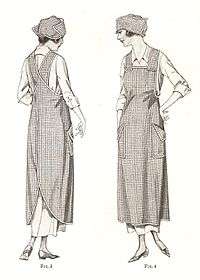1920s in Western fashion


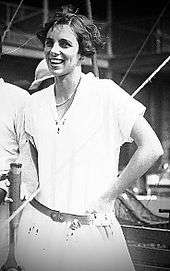
The 1920s is the decade in which fashion entered the modern era. It was the decade in which women first abandoned the more restricting fashions of past years and began to wear more comfortable clothes (such as short skirts or trousers). Men also abandoned highly formal daily attire and even began to wear athletic clothing for the first time. The suits men wear today are still based, for the most part, on those worn in the late 1920s. The 1920s are characterized by two distinct periods of fashion. In the early part of the decade, change was slow, as many were reluctant to adopt new styles. From 1925, the public passionately embraced the styles associated with the Roaring Twenties. These styles continue to characterize fashion until 1932.
Overview
After World War One, the United States entered a prosperous era and, as a result of its role in the war, came out onto the world stage. Social customs and morals were relaxed in the optimism brought on by the end of the war and the booming of the stock market. Women were entering the workforce in record numbers. The nationwide prohibition on alcohol was ignored by many. There was a revolution in almost every sphere of human activity. Fashion was no exception: as women entered the workforce and earned the right to vote, fashion trends became more accessible, masculine, and practical. Flappers were a popular name given to women of this time because of what they wore. The constrictive corset, an essential undergarment to make the waist thinner, became a thing of the past.[1]
The technological development of new fabrics and new means of fastening clothing affected fashions of the 1920s. Natural fabrics such as cotton and wool were the abundant fabrics of the decade. Silk was highly desired for its luxurious qualities, but the limited supply made it expensive. In the late 19th century, "artificial silk" was first made from a solution of cellulose in France. After being patented in the United States, the first American plant began production of this new fabric in 1910; this fiber became known as rayon. Rayon stockings became popular in the decade as a substitute for silk stockings. Rayon was also used in some undergarments. Many garments before the 1920s were fastened with buttons and lacing, however, during this decade, the development of metal hooks and eyes meant that there were easier means of fastening clothing shut. Hooks and eyes, buttons, zippers or snaps were all utilized to fasten clothing.
Vastly improved production methods enabled manufacturers to easily produce clothing affordable by working families. The average person's fashion sense became more sophisticated. Meanwhile, working-class women looked for modern forms of dress as they transitioned from rural to urban careers. Taking their cue from wealthier women, working women began wearing less expensive variations on the day suit, adopting a more modern look that seemed to suit their new, technologically focused careers as typists and telephone operators.[2]
Though simple lines and minimal adornment reigned on the runways, the 1920s were not free of luxury. Expensive fabrics, including silk, velvet and satin were favored by high-end designers, while department stores carried less expensive variations on those designs made of newly available synthetic fabrics. The use of mannequins became widespread during the 1920s, and served as a way to show shoppers how to combine and accessorize the new fashions. The modern fashion cycle, established in the 1920s, still dominates the industry today. Designers favored separates in new fabrics like jersey that could be mixed and matched for work and modern, informal, un-chaperoned social activities like attending films or the theater and car rides.[2]
Womenswear

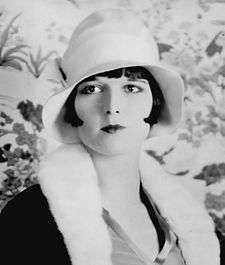
Clothing fashions changed with women's changing roles in society, particularly with the idea of new fashion. Although society matrons of a certain age continued to wear conservative dresses, the sportswear worn by forward-looking and younger women became the greatest change in post-war fashion. The tubular dresses of the 'teens had evolved into a similar silhouette that now sported shorter skirts with pleats, gathers, or slits to allow motion. The most memorable fashion trend of the “Roaring '20s” was undoubtedly “the flapper” look. The flapper dress was functional and flattened the bust line rather than accentuating it.[1]
The straight-line chemise topped by the close-fitting cloche hat became the uniform of the day. Women "bobbed", or cut, their hair short to fit under the popular hats, a radical move in the beginning, but standard by the end of the decade. Low-waisted dresses with fullness at the hemline allowed women to literally kick up their heels in new dances like the Charleston. In 1925, "shift" type dresses with no waistline emerged. At the end of the decade, dresses were being worn with straight bodices and collars. Tucks at the bottom of the bodices were popular, as well as knife-pleated skirts with a hem approximately one inch below the knee.[3]
In the world of art, fashion was being influenced heavily by art movements such as surrealism. After World War I, popular art saw a slow transition from the lush, curvilinear abstractions of art nouveau decoration to the more mechanized, smooth, and geometric forms of art deco. Elsa Schiaparelli is one key Italian designer of this decade who was heavily influenced by the "beyond the real" art and incorporated it into her designs.
Proper attire for women was enforced for morning, afternoon, and evening activities. In the early part of the decade, wealthy women were still expected to change from a morning to an afternoon dress. These afternoon or “tea gowns” were less form-fitting than evening gowns, featured long, flowing sleeves, and were adorned with sashes, bows, or artificial flowers at the waist. Evening gowns were typically slightly longer than tea gowns, in satin or velvet, and embellished with beads, rhinestones, or fringe.[2]
- The boyish figure
Undergarments began to transform after World War I to conform to the ideals of a flatter chest and more boyish figure. The women's rights movement had a strong effect on women's fashions. Most importantly, the confining corset was discarded, replaced by a chemise or camisole and bloomers, later shortened to panties or knickers. During the mid-1920s, all-in-one lingerie became popular.
For the first time in centuries, women's legs were seen with hemlines rising to the knee and dresses becoming more fitted. A more masculine look became popular, including flattened breasts and hips, short hairstyles such as the bob cut, Eton crop and the Marcel wave. The fashion was bohemian and forthcoming for its age.
One of the first women to wear trousers, cut her hair and reject the corset was Coco Chanel. Probably the most influential woman in fashion of the 20th century, Coco Chanel did much to further the emancipation and freedom of women's fashion.
Jean Patou, a new designer on the French scene, began making two-piece sweater and skirt outfits in luxurious wool jersey and had an instant hit for his morning dresses and sports suits. American women embraced the clothes of the designer as perfect for their increasingly active lifestyles.
By the end of the 1920s, Elsa Schiaparelli stepped onto the stage to represent a younger generation. She combined the idea of classic design from the Greeks and Romans with the modern imperative for freedom of movement. Schiaparelli wrote that the ancient Greeks "gave to their goddesses... the serenity of perfection and the fabulous appearance of freedom." Her own interpretation produced evening gowns of elegant simplicity. Departing from the chemise, her clothes returned to an awareness of the body beneath the evening gown.
- Style gallery 1920–25
 1 - 1920
1 - 1920 2 - 1921
2 - 1921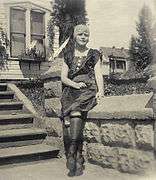 3 - 1922
3 - 1922 4 - 1922
4 - 1922 5 - early 1920s
5 - early 1920s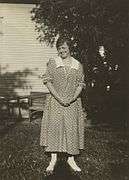 6 - 1923
6 - 1923 7 - 1924
7 - 1924 8 - 1925
8 - 1925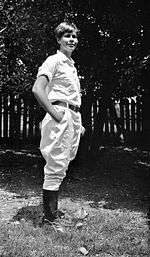 9 - 1920s
9 - 1920s 10 - 1920s
10 - 1920s
- 1920 summer sport suit.
- The forehead was usually covered in the 1920s, here by a hat reaching to the eyebrows.
- 1922 Rolled stockings.
- 1922 Robe de style, Lanvin.
- Actress Norma Talmadge in formal wear, early 1920s.
- Dress of 1923 has a dropped waist and width at the hips.
- Teenage girls in Minnesota wear breeches and riding boots with men's neckties, 1924.
- By 1925, skirts ended just below the knee. Tunic-tops and sweaters reaching to the hips were popular.
- Woman with bobbed hair in breeches and boots, 1920s.
- Actress Evelyn Brent, in the mid-1920s with bobbed hair.
- Style gallery 1926–29
 1 – 1926
1 – 1926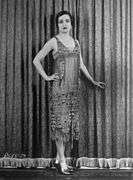 2 – 1926
2 – 1926.jpg) 3 – 1926
3 – 1926 5 – 1927
5 – 1927 6 - 1927
6 - 1927 7 - late 1920s
7 - late 1920s 8 – May 1928
8 – May 1928 9 – 1929
9 – 1929 10 – 1929
10 – 1929
- Actress Aileen Pringle wears a cloche hat and boldly patterned coat, 1926.
- Actress Alice Joyce in a straight dress with a sheer beaded overdress, 1926.
- This 1926 painting shows the mid-decade silhouette at its simplest: languid pose, bobbed hair, knee-length dress with dropped waist.
- featured simple lines and emphasis at the hips. Hair is parted to one side and worn in soft waves. Portrait of Alisa Mellon Bruce, 1926.
- Designers used multiple hemlines (here, tiers of ruffles) to accustom the eye to longer skirts. This dress foreshadows the higher waist and feminine look that spread to everyday fashion by the early 1930s.
- Actress Vilma Bánky wearing cloche hat, 1927.
- Lady hiding a hip flask tucked in her garter belt during Prohibition, 1920s.
- May 1928, abdomen and curves. After many years of a "stovepipe" silhouette, "natural" curves were beginning to reappear.[4]
- Knee-length, pleated skirts and dropped waists were still popular as everyday clothes in 1929, though Paris designers were already showing longer skirts and higher waistlines.
- Bridesmaids gowns of 1929 have knee-length underskirts and longer, sheer over skirts, foreshadowing the trend toward longer skirts. Minnesota, 1929
Menswear
In menswear there were two distinct periods in the 1920s. Throughout the decade, men wore short suit jackets, the old long jackets being used merely for formal occasions. In the early 1920s, men's fashion was characterized by extremely high-waisted jackets, often worn with belts. Lapels on suit jackets were not very wide as they tended to be buttoned up high. This style of jacket seems to have been greatly influenced by the uniforms worn by the military during the First World War. Trousers were relatively narrow and straight and they were worn rather short so that a man's socks often showed. Trousers also began to be worn cuffed at the bottom at this time.
By 1925, wider trousers commonly known as Oxford bags came into fashion, while suit jackets returned to a normal waist and lapels became wider and were often worn peaked. Loose-fitting sleeves without a taper also began to be worn during this period. During the late 1920s, double-breasted vests, often worn with a single-breasted jacket, also became quite fashionable. During the 1920s, men had a variety of sport clothes available to them, including sweaters and short trousers (commonly known in American English as knickers). For formal occasions in the daytime, a morning suit was usually worn. For evening wear men preferred the short tuxedo to the tail coat, which was now seen as rather old-fashioned and snobby.
Men’s fashion also became less regimented and formal. Men favored short jackets with two or three buttons rather than jackets with long tailcoats as well as pinstriped suits. Casual-wear for men often included knickers, short pants that came to the knee.[1]
The most formal men's suit consisted of a black or midnight-blue worsted swallow-tailed coat trimmed with satin, and a pair of matching trousers, trimmed down the sides with wide braid or satin ribbon.[5] A white bow tie, black silk top hat, white gloves, patent leather Oxford shoes, a white silk handkerchief, and a white flower boutonnière completed the outfit. The tuxedo vest could be black or white, but, unlike the obligatory full-dress white tie, tuxedos ties were always black. Men usually completed their tuxedo outfit with all the same accessories as the full-dress suit, except that instead of top hats they would wear dark, dome-shaped hats called bowlers. Just like women, men had certain attire that was worn for certain events. Tuxedos were appropriate attire at the theater, small dinner parties, entertaining in the home, and dining in a restaurant. During the early 1920s, most men's dress shirts had, instead of a collar, a narrow neckband with a buttonhole in both the front and back. By the mid-1920s, however, many men preferred shirts with attached collars, which were softer and more comfortable than rigid, detachable collars.[5]
- Men's hats
Men's hats were usually worn depending on their class, with upper class citizens usually wearing top hats or a homburg hat. Middle class men wore either a fedora, bowler hat or a trilby hat. During the summer months a straw boater was popular for upper class and middle class men. Working-class men wore a standard newsboy cap or a flat cap.
Facts
During the 1920s, the notion of keeping up with fashion trends and expressing oneself through material goods seized middle-class Americans as never before. Purchasing new clothes, new appliances, new automobiles, new anything indicated one's level of prosperity. Being considered old-fashioned, out-of-date, or—worse yet—unable to afford stylish new products was a fate many Americans went to great lengths to avoid.[5]
For women, face, figure, coiffure, posture and grooming had become important fashion factors in addition to clothing. In particular, cosmetics became a major industry. Glamour was now an important fashion trend, due to the influence of the motion picture industry and the famous female movie stars. Style, at many social levels, was heavily influenced by the newly created, larger-than-life movie stars. For the first time in history, fashion influences and trends were coming from more than one source.[3] Not unlike today, women and men of the 1920s looked to movie stars as their fashion icons. Women and men wanted to emulate the styles of Hollywood stars such as Louise Brooks, Greta Garbo, Rudolph Valentino, and Clark Gable.[1]
- Style gallery
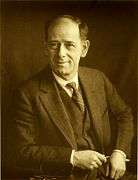 1 - c. 1920
1 - c. 1920 2 - 1923
2 - 1923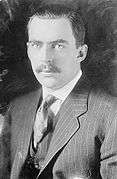 3 - 1924
3 - 1924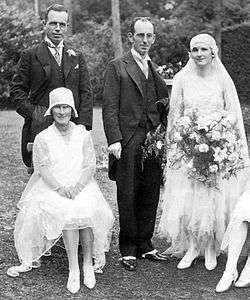 4 - 1929
4 - 1929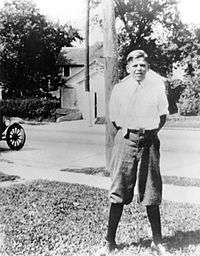 5 - 1920s
5 - 1920s 6 - 1927
6 - 1927 7 - 1927
7 - 1927 8 - 1929
8 - 1929
- Photographer Clarence Hudson White, c. 1920.
- Politician William J. Fields wears an overcoat and soft-crowned hat with a bow tie, December 1923.
- Publisher Edward Beale McLean wears a three-piece striped suit with a spread-collar shirt, 1924.
- Men wear morning dress and spats in this 1929 wedding photo.
- Ronald Reagan as a teenager wearing knickerbockers.
- Man in 1927 wearing a Panama hat and buttoned waistcoat.
- Charles Lawrence, 1st Baron Lawrence of Kingsgate wears a stuff collar and bow tie.
- German aviators, one a prince, 1929
Work clothes
For working class women in the 1920s, tailored suits with a straight, curveless cut were popular. Throughout the decade, the lengths of skirts were rise to the knee and then to the ankle various times affecting the skirt style of tailored suits.[6] Rayon, an artificial silk fabric, was most common for working class women clothing.[7]
For working class men in the 1920s, suits were popular. Depending on the job title and season of the year, the suit would change.[8]
Children's fashion
Fashion for children started to become more stylish and comfortable in the 1920s. Clothes were made out of cotton and wool rather than silk, lace, and velvet. Clothes were also made more sturdy in order to withstand against play. During previous decades, many layers were worn. However, during the 1920s, minimal layers became the new standard.[9]
For girls, clothing became more loose and short. Dresses and skirts were now knee length and loose fitting. Shoes were also made out of canvas, making them lighter and easily to wear.[9]
For boys, knee-length trousers were worn all year long and would be accompanied by ankle socks and canvas shoes. Pullovers and cardigans were also worn when the weather became cooler.[9]
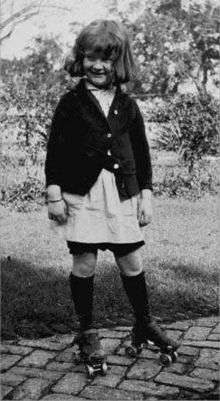 1 – 1921
1 – 1921 3 – 1925
3 – 1925 4 – 1927
4 – 1927 5 - 1920s
5 - 1920s
- Roller-skater, Mississippi, 1921
- Knee-length dress worn with anklets and Mary Janes, 1923.
- Children's fashion, Germany, 1925
- Two-year-old Paulina, with her mother Alice Roosevelt Longworth, wears a winter costume of coat and trousers, 1927.
- Young boy wears a sailor suit.
See also
Notes
- 1 2 3 4 Marsha West. Fashion Trends of the Twenties. July 1, 2008.
- 1 2 3 Fashion in the 1920s (Overview). Pop Culture Universe: Icons, Idols, Ideas. ABC-CLIO, 2011. Retrieved December 24, 2012.
- 1 2 Carol Nolan. "Ladies Fashions of the 1920’s". Retrieved December 24, 2012.
- ↑ "Back to Beauty". The Spirella Magazine. May 1928. p. 72.
- 1 2 3 Bob Batchelor. "Fashion in the 1920s". American Pop: Popular Culture Decade by Decade, Volume 1: 1900–1929. Greenwood Press, 2009. pp. 292-302.
- ↑ Vermont, Jens Hilke, University of. "Women's Clothing - 1920s - Clothing - Dating - Landscape Change Program". www.uvm.edu. Retrieved 2016-11-15.
- ↑ "History of Womens Fashion - 1920 to 1929 | Glamourdaze". glamourdaze.com. Retrieved 2016-11-15.
- ↑ "What Did Women & Men Wear in the 1920s?". VintageDancer.com. 2013-06-21. Retrieved 2016-11-15.
- 1 2 3 "1920 Children's Fashion Facts". LoveToKnow. Retrieved 2016-10-17.
References and further reading
| Wikimedia Commons has media related to 1920s fashion. |
- Arnold, Janet: Patterns of Fashion 2: Englishwomen's Dresses and Their Construction C.1860–1940, Wace 1966, Macmillan 1972. Revised metric edition, Drama Books 1977. ISBN 0-89676-027-8
- Black, J. Anderson, and Madge Garland, A History of Fashion, New York, Morrow, 1975
- Boucher, François: 20,000 Years of Fashion, Harry Abrams, 1966.
- Laver, James: The Concise History of Costume and Fashion, Abrams, 1979.
- Nunn, Joan: Fashion in Costume, 1200–2000, 2nd edition, A & C Black (Publishers) Ltd; Chicago: New Amsterdam Books, 2000. (Excerpts online at The Victorian Web)
- Russell, Douglas A. " Costume History and Style" Stanford University, 1983.
- Steele, Valerie: Paris Fashion: A Cultural History, Oxford University Press, 1988, ISBN 0-19-504465-7
- Steele, Valerie: The Corset, Yale University Press, 2001
- The Spirella Magazine; MAY 1928
- Children's fashion of the 1920s
External links
- 1920s Fashion Plates of men, women, and children's fashion from The Metropolitan Museum of Art Libraries
- Photographs from the 1920s taken by photographer, Henry Walker at the University of Houston Digital Library
- "1920s - 20th Century Fashion Drawing and Illustration". Fashion, Jewellery & Accessories. Victoria and Albert Museum. Retrieved 2011-04-03.
- Roaring 20's Fashion Image Gallery of 1920s Fashion
